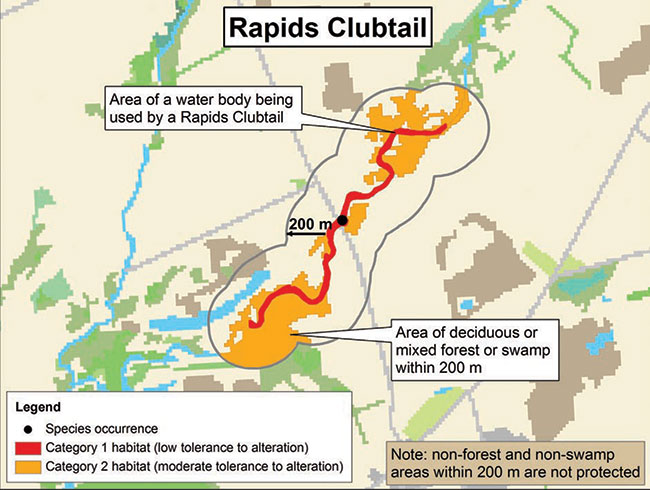Rapids Clubtail Habitat Protection Summary
This document provides a brief description of the area that is protected as habitat for the Rapids Clubtail through a habitat regulation under the Endangered Species Act, 2007.
The Rapids Clubtail is a relatively small, brightly coloured dragonfly which lays its eggs on the surface of fast flowing water. It can be found in and around clear, cool, medium-to-large rivers with wooded shorelines, gravel shallows, and muddy pools. The species is classified as threatened on the Species at Risk in Ontario List (Ontario Regulation 230/08). More information about the species' status can be found at: Rapids Clubtail.
The habitat regulation for Rapids Clubtail protects any part of a river, stream or other body of water, up to the high water mark, that is being used by a Rapids Clubtail or on which a Rapids Clubtail directly depends on in order to carry on its life processes. This aquatic habitat is protected until five consecutive years of documented non-use by a Rapids Clubtail, as long as habitat conditions remain suitable for a Rapids Clubtail to carry out its life processes. Areas of deciduous or mixed forest or swamp within 200 metres of the high water mark, adjacent to the aquatic areas identified above, are also protected.
The regulation applies where the dragonfly occurs in the following areas associated with portions of the Thames River, Humber River, and Mississippi River: the townships of Zorra and South-West Oxford within the County of Oxford; the Township of King and the City of Vaughan within the Regional Municipality of York; the Town of Caledon within the Regional Municipality of Peel; the Municipality of Thames Centre within the County of Middlesex; and the Town of Mississippi Mills within the County of Lanark.
Supporting rationale
- Aquatic habitat is used for egg laying, larval development and foraging.
- The five-year term represents approximately two-times the life span of a Rapids Clubtail and is appropriate given the small and inconspicuous nature of the species, the expertise required to find and identify it, as well as its extremely limited distribution in the province.
- Adult and sub-adult Rapids Clubtails travel between water bodies and areas of deciduous or mixed forest or swamp to access reproduction and resting/foraging sites. Protecting these habitat types within 200 metres of a water body represents the average distance traveled by most dragonflies.
Activities in Rapids Clubtail habitat
Activities in regulated habitat can continue as long as the function of these areas for the species is maintained and individuals of the species are not killed, harmed, or harassed.
Generally compatible:
- yard work such as lawn care and gardening
- pruning of shrubs or trees for maintenance purposes
- renovations or the building of small structures such as a shed or a deck
Generally not compatible
- significant reduction or clearing of forests and treed swamps
- large-scale construction, such as a housing development or roads
- substantial alteration of aquatic habitat, such as altering water flows and levels
Below you will find an example diagram of how this regulation would be applied to protect habitat for this species. It indicates how the protected habitat has been categorized, based on how the species uses the habitat and how much activity or change can occur within the habitat, as per the policy Categorizing and Protecting Habitat Under the Endangered Species Act.
Sample application of the habitat regulation

Enlarge sample application of the habitat regulation
The content of this summary is provided for convenience only. For accurate reference and the most recent version of the regulation, please view Ontario Regulation 832/21 on e-Laws.
Footnotes
- footnote[1] Back to paragraph If you are considering an activity that may not be compatible with regulated habitat, please contact your local MNR office for more information